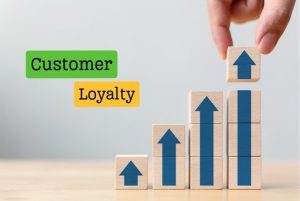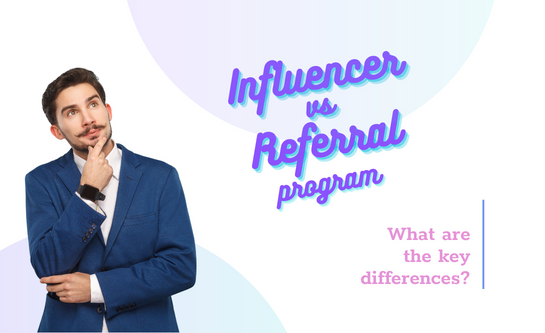Referral Program – A Secret to Reduce Customer Acquisition Cost
 Apr 05th, 2024
Apr 05th, 2024
 346 views
4 MINS READ
346 views
4 MINS READ
Are you grappling with the relentless challenge of high customer acquisition costs (CAC) in your business? In today’s deal-driven market, rising customer acquisition costs are a common obstacle faced by businesses across various industries as consumers are familiar with and driven by promotional strategies. But fret not, as there’s a potent solution that can alleviate this burden and drive sustainable growth: the referral program.
Rising CAC Across Industries
The escalating customer acquisition costs are a pressing concern for businesses of all shapes and sizes. Recent data underscores this issue, revealing a steady increase in average CAC across diverse sectors. For instance, a recent study revealed that in the E-commerce field, customer acquisition costs increased 222% within eight years, while the customer acquisition costs in higher education and insurance surpassed USD1000. The banking sector and B2B businesses are not immune to this trend, grappling with rising acquisition costs as well.
Businesses grappling with high customer acquisition costs often exhibit common symptoms across different sectors: In the B2B sphere, elongated and intricate sales cycles translate to higher acquisition costs per customer. Consumer-centric businesses encounter diminishing returns on traditional marketing channels, leading to inflated customer acquisition cost figures. Educational institutions face fierce competition in attracting and retaining students, resulting in escalating acquisition costs. Service providers contend with intense competition and price pressures, making it arduous to acquire new clients without overspending on marketing endeavors.
Solution for the high customer acquisition cost
So, what’s the ultimate remedy for combating high CAC? Enter the referral program—an astoundingly effective strategy for curbing customer acquisition costs while concurrently bolstering customer engagement and loyalty.
A referral program is a structured initiative that incentivizes existing customers or contacts to refer new customers to a business. Typically, this involves offering rewards, discounts, or other incentives to both the referrer and the new customer upon successful conversion. Naturally, the referral program applies the power of word-of-mouth marketing to convey specific messages in a trustworthy way. Differentiated from word-of-mouth marketing, which commonly is difficult to navigate and has a high risk of harming brand reputation, referral programs give incentives for ‘conveyors’ to ensure the message is spread in the right direction.
Let’s delve deeper into how referral programs benefit businesses by cutting down on customer acquisition costs.
How Referral Programs Help Businesses Reduce Costs

1. Harnessing the Power of Trust
Referral programs leverage the trust existing customers have already established with their network. People are more likely to trust recommendations from friends or family than traditional advertising. By encouraging satisfied customers to refer others, businesses tap into this trust, making it easier to acquire new customers.
2. Cost-Effective Marketing
Compared to traditional advertising channels like television, radio, or print media, referral programs are remarkably cost-effective. While implementing a referral program requires some initial investment to set up incentives and tracking mechanisms, the cost per acquisition is typically much lower than other marketing channels in the long run. Instead of spending large sums on broad advertising campaigns, businesses allocate resources towards rewarding existing customers for successful referrals, resulting in a higher return on investment.
3. Targeted Reach
Referral programs enable businesses to target specific demographics or customer segments more effectively. Since referrals often come from individuals with similar interests or needs, businesses can tailor their referral incentives to appeal to these target audiences. This targeted approach increases the likelihood of acquiring customers who are genuinely interested in the products or services offered, further optimizing the cost-effectiveness of customer acquisition efforts.
4. Enhanced Customer Loyalty
Referral programs not only attract new customers but also reinforce loyalty among existing ones. When customers are rewarded for successful referrals, they feel appreciated and valued by the business. This positive reinforcement strengthens the bond between the customer and the brand, leading to increased retention rates and higher lifetime value. In essence, referral programs serve as a win-win scenario for both the business and its customers.

5. Sustainable Growth
Unlike one-time marketing campaigns that generate a temporary spike in customer acquisition, referral programs foster sustainable, long-term growth. As satisfied customers continue to refer others, the network effect takes hold, resulting in a steady stream of new customers over time. This organic growth not only reduces the need for continuous spending on expensive marketing campaigns but also strengthens brand loyalty and customer engagement.
6. Augmenting Customer Lifetime Value:
Referral programs have emerged as a powerful tool for businesses to augment their Customer Lifetime Value (CLV) in recent years. Referred customers often display stronger loyalty and higher retention rates, ultimately contributing significantly to the overall CLV. Implementing a well-designed referral program not only fosters customer engagement and satisfaction but also fuels organic growth, making it a vital strategy for businesses looking to maximize their long-term profitability and sustainability. The most convenient way to build a well-designed referral program is using the referral feature of ezLoyalty as it helps your business create referral programs easily and swiftly, enables creating engagement actions, special discounts, and config VIP service.
Conclusion
Referral programs are a powerful tool for businesses looking to reduce customer acquisition costs while simultaneously driving sustainable growth and fostering customer loyalty. By leveraging the trust and influence of satisfied customers, businesses can tap into new markets and expand their reach at a fraction of the cost of traditional marketing channels. Along with key promotional programs such as buy one get one free, referral programs remain a cost-effective and efficient strategy for acquiring and retaining customers in a competitive marketplace. Embracing the potential of referral marketing can unlock new opportunities for businesses to thrive and succeed in the digital age.
 Back to blog page
Back to blog page





























